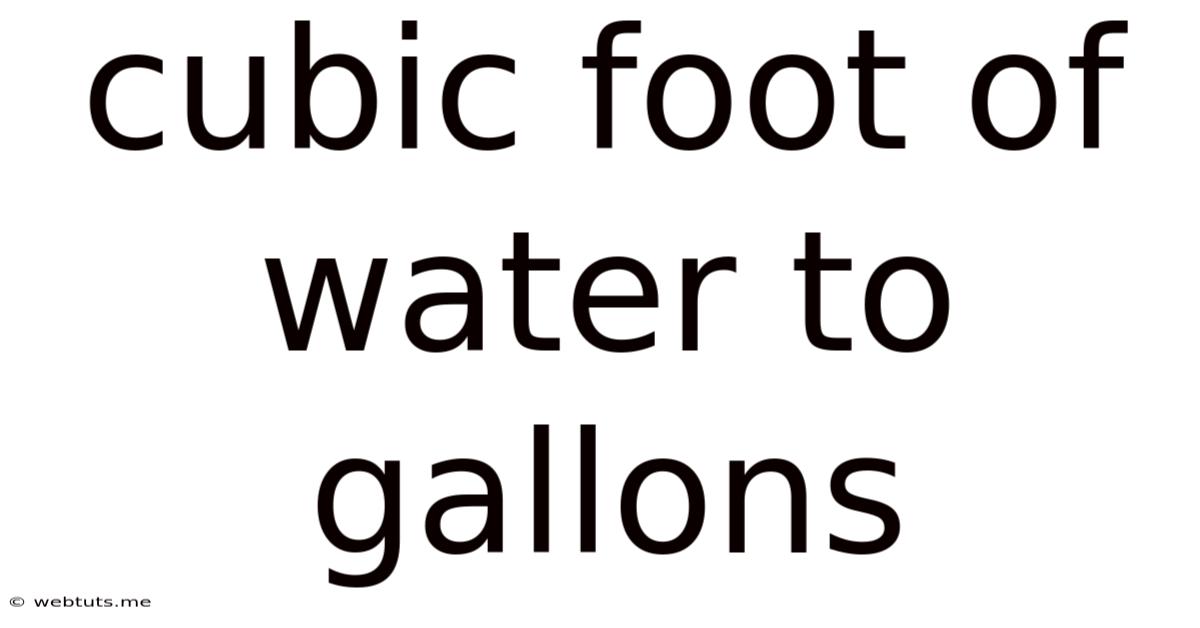Cubic Foot Of Water To Gallons
Webtuts
May 13, 2025 · 4 min read

Table of Contents
Cubic Foot of Water to Gallons: A Comprehensive Guide
Understanding the relationship between cubic feet and gallons is crucial in various applications, from plumbing and irrigation to construction and water management. This comprehensive guide delves into the conversion process, explains the underlying principles, and provides practical examples to solidify your understanding. We'll cover everything from the basic conversion factor to real-world scenarios, ensuring you're equipped to handle any cubic foot to gallon calculation with confidence.
Understanding the Units
Before diving into the conversion, let's clarify the units involved:
-
Cubic Foot (ft³): A unit of volume representing the space occupied by a cube with sides measuring one foot each. Imagine a box 1 foot wide, 1 foot long, and 1 foot high; that's one cubic foot.
-
Gallon (gal): A unit of volume commonly used to measure liquids. The US gallon and the Imperial gallon differ slightly in volume, leading to different conversion factors. This guide primarily focuses on the US gallon, unless otherwise specified.
The Conversion Factor: Cubic Feet to Gallons
The key to converting cubic feet to gallons lies in the conversion factor: 1 cubic foot of water is equal to approximately 7.48 US gallons. This isn't an exact number, as the density of water can vary slightly depending on temperature and pressure. However, 7.48 is a sufficiently accurate approximation for most practical purposes.
The Formula
The conversion formula is straightforward:
Gallons = Cubic Feet × 7.48
This means you simply multiply the number of cubic feet by 7.48 to get the equivalent number of US gallons.
Practical Examples
Let's illustrate the conversion with several examples:
Example 1: A swimming pool has a volume of 500 cubic feet. How many gallons of water does it hold?
Gallons = 500 ft³ × 7.48 gal/ft³ = 3740 gallons
Therefore, the swimming pool holds approximately 3740 gallons of water.
Example 2: A water tank measures 2 feet wide, 3 feet long, and 4 feet high. What is its capacity in gallons?
First, we calculate the volume in cubic feet:
Volume = length × width × height = 2 ft × 3 ft × 4 ft = 24 ft³
Now, we convert cubic feet to gallons:
Gallons = 24 ft³ × 7.48 gal/ft³ = 179.52 gallons
The water tank can hold approximately 179.52 gallons of water.
Example 3: You need to fill a 1000-gallon fish tank. How many cubic feet of water do you need?
This time, we need to rearrange the formula:
Cubic Feet = Gallons / 7.48
Cubic Feet = 1000 gal / 7.48 gal/ft³ ≈ 133.6 ft³
You'll need approximately 133.6 cubic feet of water.
Considerations and Refinements
While the 7.48 conversion factor is generally accurate, several factors can influence the precise conversion:
-
Temperature: The density of water changes slightly with temperature. Colder water is denser, meaning a cubic foot of cold water will contain slightly more mass (and thus, slightly more weight) than a cubic foot of warm water. This difference is usually negligible for most applications.
-
Pressure: Similarly, pressure also affects water density. The impact is typically minimal unless you're dealing with extremely high pressures.
-
Imperial Gallons vs. US Gallons: Remember that the conversion factor changes if you're using Imperial gallons (used in the UK and some other Commonwealth countries). The conversion factor for Imperial gallons is different and will result in a larger volume compared to US gallons.
-
Dissolved Substances: Water often contains dissolved minerals, salts, and other substances. These substances increase the overall density, but the effect is usually minor for typical water sources.
Advanced Applications and Calculations
Beyond simple volume conversions, understanding cubic feet to gallons conversion is vital in various fields:
-
Plumbing: Calculating water flow rates, pipe sizes, and tank capacities.
-
Irrigation: Determining water requirements for agricultural fields and landscaping.
-
Construction: Estimating the amount of concrete, water, and other materials needed for projects.
-
Aquariums and Fishkeeping: Calculating tank volume and water changes.
-
Civil Engineering: Estimating water storage capacity for dams and reservoirs.
-
Environmental Science: Measuring water flow in rivers and streams.
Troubleshooting Common Mistakes
-
Using the wrong conversion factor: Always double-check that you're using the correct conversion factor (7.48 for US gallons).
-
Incorrect unit calculations: Ensure you're working with consistent units throughout your calculations (e.g., all measurements in feet).
-
Rounding errors: While rounding is acceptable for many applications, be mindful of potential accumulation of errors in complex calculations.
Conclusion
The conversion from cubic feet to gallons is a fundamental calculation with wide-ranging applications. Understanding the underlying principles, mastering the conversion formula, and being aware of potential influencing factors will equip you to handle various scenarios confidently. From everyday tasks to complex engineering projects, this knowledge proves invaluable. Remember to always double-check your calculations and consider the specific context to ensure accuracy and avoid costly mistakes. By mastering this simple conversion, you'll enhance your problem-solving abilities in numerous fields, simplifying tasks and improving efficiency. This guide provides a solid foundation for tackling any cubic feet to gallon conversion challenge.
Latest Posts
Latest Posts
-
How Many Gallons Is 21 Quarts
May 13, 2025
-
How Many Sticks Of Butter Equal 1 1 2 Cups
May 13, 2025
-
How Many Km Is 60 Mph
May 13, 2025
-
How Many Tons Is 245 Pounds
May 13, 2025
-
How Many Days Until January 14th 2025
May 13, 2025
Related Post
Thank you for visiting our website which covers about Cubic Foot Of Water To Gallons . We hope the information provided has been useful to you. Feel free to contact us if you have any questions or need further assistance. See you next time and don't miss to bookmark.